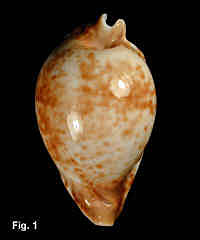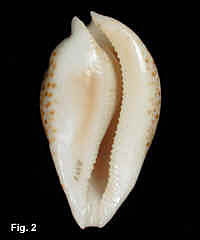|
|
|
|
Cypraea hesitata (Iredale, 1916) Description: Teeth fine, barely extending out of the aperture. Ends extended, spire sunken, margins rounded. In the most common colour form (Fig. 1a, 1b) base white with a light brown patch on the columella side, sides white with brown spots, dorsal surface mottled brown and white with ends light brown. Size: Up to 121 mm in length. The smallest adult specimen known to the author measures 49 mm. Distribution: Restricted to eastern and south-eastern Australia. Known from Capricorn Group, Qld, southwards to Adventure Bay in south-eastern Tasmania, and westward through Bass Strait to north-western Tasmania. Habitat: Trawled in 50-400 m. Commonly trawled off Sydney in about 100-120 m on a muddy bottom. Locally common. Remarks: This species is quite variable in shape, size and colour, generally becoming smaller and darker with northerly progression through its range. Some of the forms have been named as subspecies, but as intergrades occur between them the names are best regarded as applying to extreme forms. In Bass Strait and northwards to southern NSW shells are large and light coloured (Fig. 3). Occasional albino specimens occur (Fig.4), these having been named Umbilia howelli Iredale, 1931. Integrades between the normal and albino form occur (Fig. 5). Shells taken off Sydney, named beddomei Schilder, 1930, are small and darker (Fig 6). At the ends of the range of Cypraea hesitata shells occur which are closely related but are sufficiently different to justify specific separation. To the north, specimens taken in 100-300 fathoms in the Capricorn Channel and off the Swain Reefs have been named Cypraea capricornica Lorenz, 1989. Several forms have been obtained, the most common being a small, heavy shell from 100-150 fathoms in the Swain Reefs area (Fig. 7) (Lorenz, 1988). In the south, Cypraea armeniaca Verco, 1912 is a closely related species which occurs in the Great Australian Bight, but neither species appear to occur between Port Lincoln and north-western Tasmania. Figs. 1,2: Off Cronulla, NSW, in 70-72 fm. (128-132 m) (DLB2397) |

